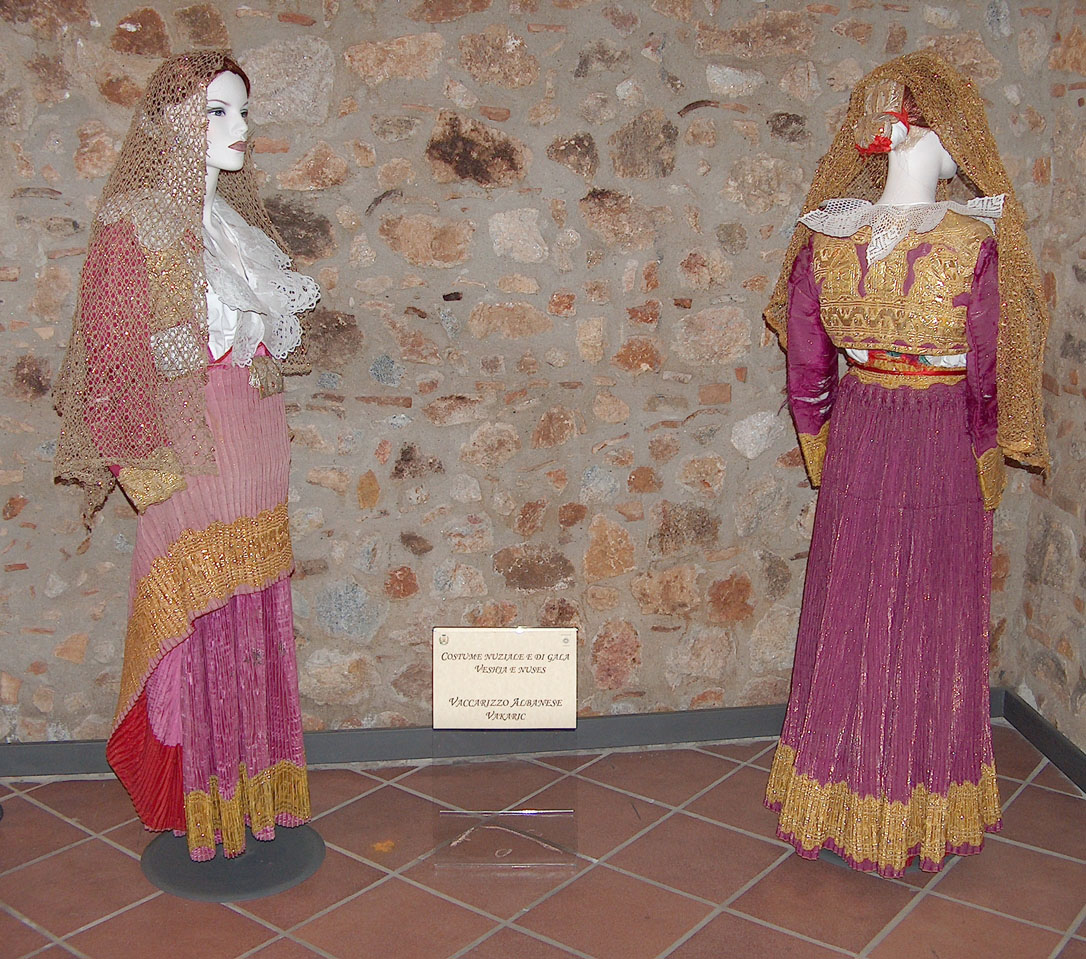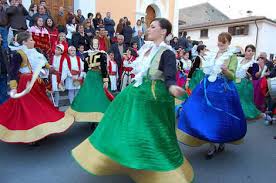
The Museum of Arbëreshe Costume
This project is based on the experience gained so far by the Museum of the Arbëreshe Costume of Vaccarizzo Albanese (Cs) and the Festival of the Albanian Costume, which every year sees the participation of delegations from all over Calabria.
There are many linguistic minorities in Italy, but the largest is certainly the Arbëreshe. The Albanians of Italy, with the first groups arrived around the fifteenth century in order to escape the Turkish-Ottoman advance throughout the Balkans, settled mainly in our South, and more extensively in Calabria, where about 100,000 Albanians still live.
However, all minority communities in Italy in different ways and at different levels are facing the challenge of decline. The elderly are leaving, and unless there is someone who realizes the value of what is being lost to encourage the community to rediscover its roots, they will be taking with them the proverbs, the songs, the pieces of a world.
This is what the Municipality of Vaccarizzo Albanese is doing. It is a small hilly town with just over a thousand inhabitants at the foot of the Greek Sila, facing the plain of Sibari, rich in centuries-old olive groves and golden orange trees along the Ionian Sea. Its Museum of Arbëreshe Costume, located in the Palazzo Cumano, was established by the Municipal Administration and by Papàs Giuseppe Faraco in 1984. Activities related to the museum include the enchanting annual festival of the costume with representatives from many towns, who are laboriously but passionately directed by Silvia Tocci, where original clothes are conserved, some of which are more than 100 years old, originating from the many Albanian towns of Calabria.
Today in Arberia, named in homage to the motherland and formed by a handful of small villages that overlook the Ionian coast, there are barely 2-3 women who still wear the traditional costume. although wearing it is gaining popularity due to the desire of young girls to marry in the Arbëreshe costume. Let's take a closer look at these wonders, aided by the precise and detailed notes found on the Municipality's website.
The costume
 The costume, preserved from generation to generation, still represents a strong symbol of identity and ethnic belonging. in the sense that it is impossible not to take into account the relationships between our culture and the official one. Despite this, the Arbëreshe costumes, although differing in styles and colors, have maintained the original meaning of the areas of Albanian origin and the composition of some elements: the wedding tiara, the veil, the shirt with lace, the long skirt with thick pleats, the belt.
The costume, preserved from generation to generation, still represents a strong symbol of identity and ethnic belonging. in the sense that it is impossible not to take into account the relationships between our culture and the official one. Despite this, the Arbëreshe costumes, although differing in styles and colors, have maintained the original meaning of the areas of Albanian origin and the composition of some elements: the wedding tiara, the veil, the shirt with lace, the long skirt with thick pleats, the belt.
Worn today only by a few elderly women, the costume in the past was part of the dowry of every girl who from then on would wear it at the most important events of her life. The gala dress was worn, in fact, on the day of the wedding with a fitting that was really a true ritual, and then on the occasion of happy events related to family and society.Wearing the traditional styles of dress was then prolonged in mourning and until not long ago it was customary to dress the deceased with their wedding dress. In addition to the normal dowry, the bride received costumes to wear on weekdays as well as on holidays. The arbëresh costume presents, therefore, different categories: the gala costume, the costume of half a feast and also the daily costume and that of mourning.
The material used to create these costumes was wool for the peasants, and cotton, linen and silk for the higher class. Fabrics were often produced in the domestic context as well as the costumes that were made with them. From the 18th century onwards, the different economic and social conditions allowed the Arbëreshë of Italy to entrust the sewing of the various styles to local master craftsmen who began to enrich the costumes according to the degree of wealth of those who requested it, varying the quality, workmanship and quantity of the ornaments. All this led to the adoption of more precious fabrics, laminated in gold, velvet, etc., which arrived above all from Naples, the center of cultural influence for the Arbëreshe communities as well as for the whole of Southern Italy.
Gala costume
 On her wedding day, the bride wore the splendid gala costume. The long white linen or cotton blouse with a collar adorned with precious crocheted lace or tulle, had a deep neckline closed by a small white cotton coverlet and embroidery at sight. On the shirt a short bodice, open on the front in gold laminated fabric and the same color of the overskirt, amaranth. The bodice had, in addition, cuffs flaps and the part of the shoulders, adorned with precious gold chevrons. Particularly beautiful and elaborate skirt and overskirt with thick pleats obtained with the technique of steam. The first in silk satin laminated in gold in shades of red and wide gold chevron, the second overlapping this, pure silk laminated in gold and gold chevron usually pink. The outer-skirt was raised on the front and fixed behind, in order to allow the bride to show also the skirt. Around the waist the bride wore a thin belt made of gold or silver threads with a rectangle closure placed at the height of the belly and embroidered with the same ornamental motifs of the wedding tiara. These two elements were the distinctive symbol of the married woman.
On her wedding day, the bride wore the splendid gala costume. The long white linen or cotton blouse with a collar adorned with precious crocheted lace or tulle, had a deep neckline closed by a small white cotton coverlet and embroidery at sight. On the shirt a short bodice, open on the front in gold laminated fabric and the same color of the overskirt, amaranth. The bodice had, in addition, cuffs flaps and the part of the shoulders, adorned with precious gold chevrons. Particularly beautiful and elaborate skirt and overskirt with thick pleats obtained with the technique of steam. The first in silk satin laminated in gold in shades of red and wide gold chevron, the second overlapping this, pure silk laminated in gold and gold chevron usually pink. The outer-skirt was raised on the front and fixed behind, in order to allow the bride to show also the skirt. Around the waist the bride wore a thin belt made of gold or silver threads with a rectangle closure placed at the height of the belly and embroidered with the same ornamental motifs of the wedding tiara. These two elements were the distinctive symbol of the married woman.
The hair was gathered on the nape of the neck in braids and knotted with white ribbons to which two small lateral braids were joined by a black ribbon in order to form a single chignon on which the wedding diadem was placed.
The costume was completed by: amaranth satin stole bordered by gold chevron and worn on the shoulders, veil made of gold threads or red tulle with gold embroidery that covered the face and head of the bride, white cotton stockings knitted and shoes covered with the same fabric of the overskirt. The gala dress was, finally, made more precious by the gold ornaments worn: the red gold necklace and double bow pendant with a pendant decorated with colored enamels, on the ring finger of the right hand the ring of faith, on the lace a brooch, the ears beautiful earrings with fringe that resumed the ornamental motifs of the necklace and the brooch.
Costume of minor festivity
The costume for minor party, worn by the bride to go to church on Sundays after the wedding, for courtesy visits or on the occasion of festivities, included the long white linen or cotton blouse with a collar adorned with lace, the skirt with thick pleats in amaranth-colored satin adorned on the hem with a large gold braid, or if it was less important occasions, the pleated skirt in raw silk and cotton or combed wool adorned along the bottom edge with a strip of green satin fabric. The bodice made of black cloth or velvet was adorned at the shoulders and wrists by wide bands of gold braid, the sleeves were finished with precious embroidery, also in gold, with floral motifs. The dress of minor festivity was, moreover, completed by an apron of blue silk embroidered with gold threads, by a headscarf of yellow or orange silk and finally by a green or brown shawl of fine wool and adorned with bangs.
Daily costume
There are very few elderly women today who wear the daily costume, a simple costume in appearance both in the shape and in the fabrics, but in reality, not easy to wear or to carry. The long linen or white cotton shirt is worn under a sort of cotton vest sturdy of various colors with the function of supporting the breast. The deep neckline of the shirt is closed by a small bodice cover in order to better cover the breast and allow, once, some movements during the work in the fields. The bodice is made of satin, wool or black velvet and embroidered with black silk thread. The skirt worn is made of red cotton with the bottom adorned with a ruffled flounce. The head is covered by a cotton or wool handkerchief tied behind the nape of the neck, the lap by a cotton apron.
Festival of the arbëreshe costume
Finally, the festival that is held every year (today's Covid permitting): it is an opportunity for promotion as well as enhancement of our cultural heritage. During the three days of the festival you can attend conferences, exhibitions and parades of 10 Costume of Pasquai, traditional costumes from numerous Arbëreshe communities. In addition, in the evening, performance of traditional dances and songs by the groups present and tasting of typical dishes and sweets, as depicted in this last beautiful forum of women in Easter costume.
This is all that remains in our memory of the arbëreshe, or rather of the Albanians of Italy, who landed in the mid-fifteenth century. But the most serious thing - Silvia Tocci points out with regret - is that we are also losing the language.
Of course, for many years there have been state and regional funds for the defense of linguistic minorities with Albanian language courses in some elementary and middle school classes, but for over ten years they no longer exist (sic!).
(Text written by Dr. Michele Minisci) .


